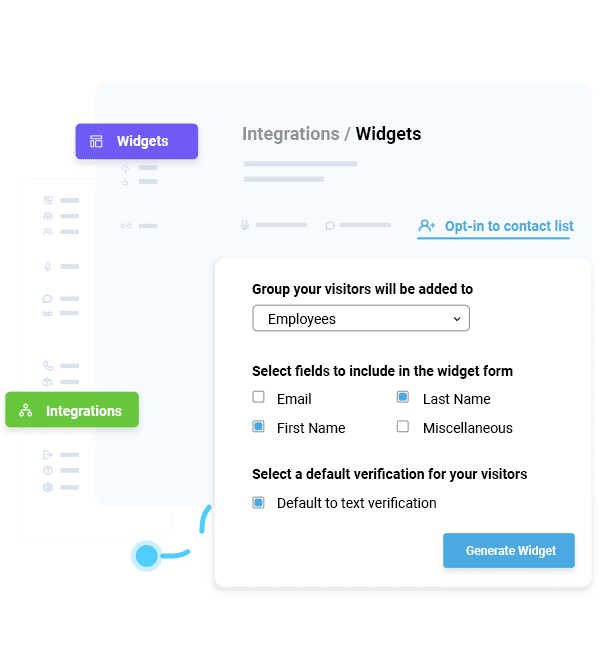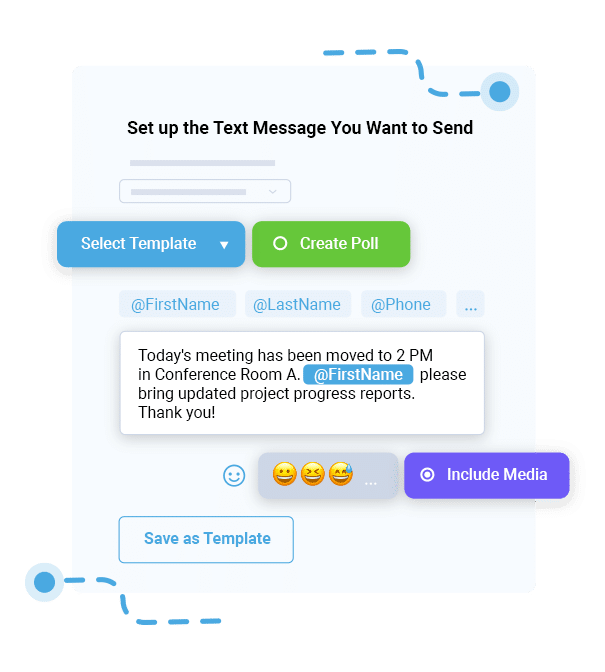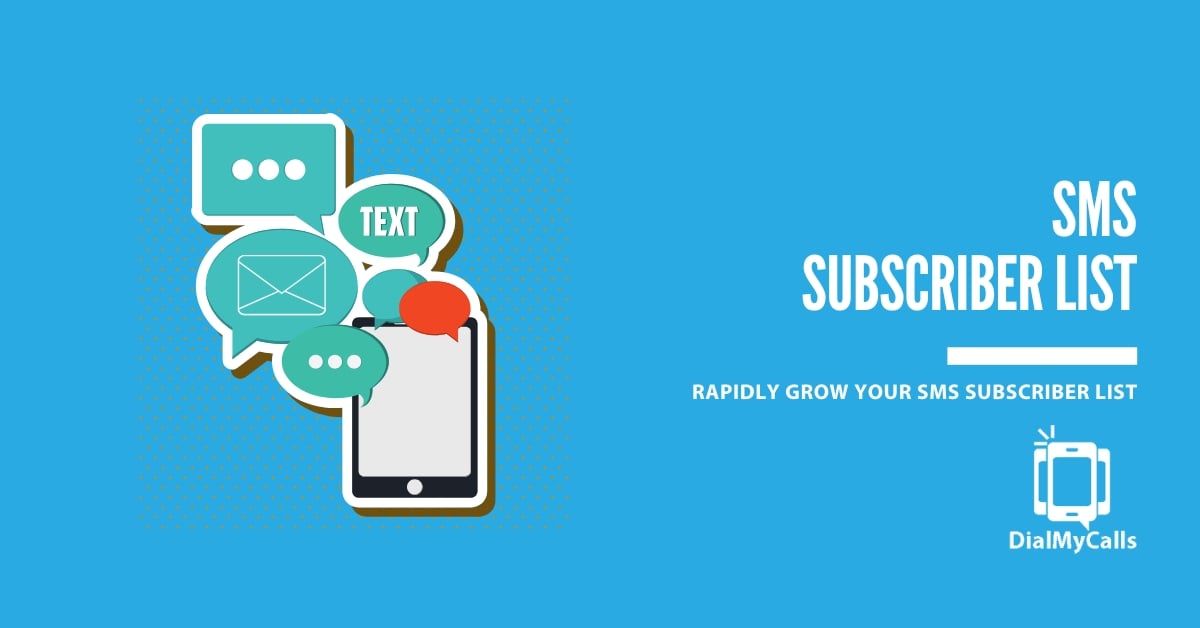Author
Tim Smith is the Media Manager at DialMyCalls, where he has leveraged his expertise in telecommunications, SaaS, SEO optimization, technical writing, and mass communication systems since 2011. Tim is a seasoned professional with over 12 years at DialMyCalls and 15+ years of online writing experience.
Try Using DialMyCalls Right Now
Start For FreeRecent Posts
- 10 Proven Tips To Rapidly Grow Your SMS Subscriber List
- SMS Marketing Metrics: How to Measure and Improve Your Text Campaign’s Success
- What are SMS Carrier Fees and How to Lower Your Costs
- 8 Creative SMS Marketing Ideas to Boost Engagement This Summer
- 15 Ways to Use QR Codes For Event Promotion & Attendee Engagement
Categories
“I am a youth minister and have spent hours in the past calling students individually to remind them of an upcoming event or to get out an urgent announcement. With DialMyCalls.com, I cut that time down to about 1 minute. I also love how I can see exactly who answered live and how long they listened so I know if they heard the whole message. DialMyCalls.com is the best website I have stumbled upon all year! Thanks!”
Central Baptist Church
Try Using DialMyCalls Right Now
Start For FreeHow to Collect Phone Numbers for Effective SMS Campaigns
Posted by Tim Smith in Business Continuity on October 15, 2024
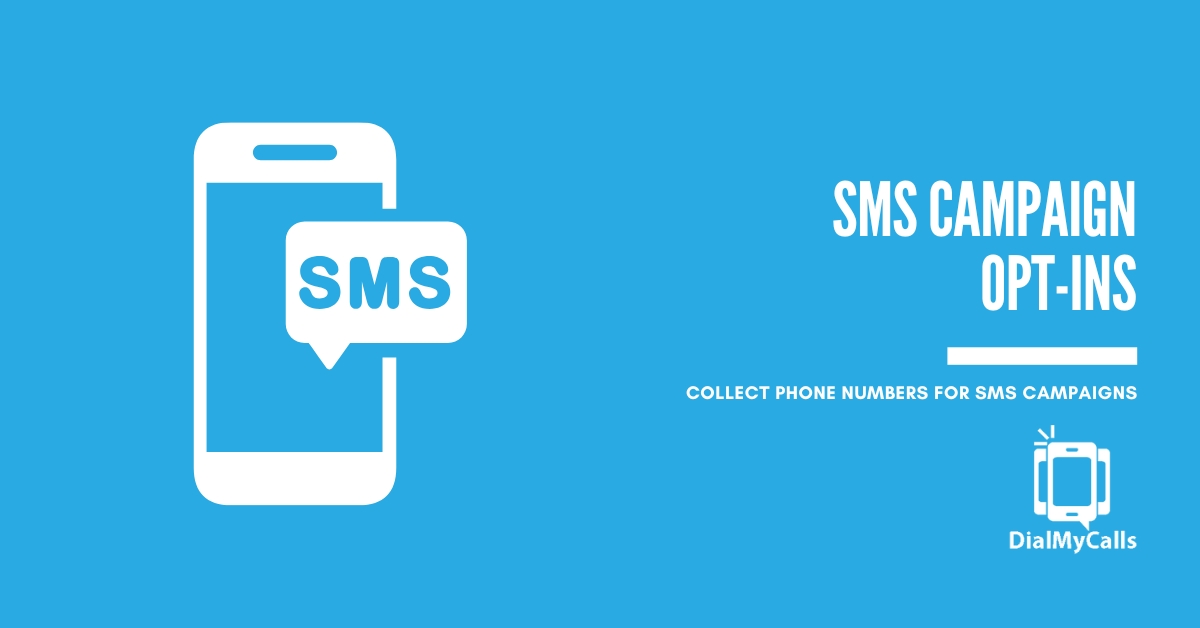
As simple as it may sound, SMS marketing is, in fact, one of the most powerful tools in a marketer’s arsenal today. With open rates as high as 98%, SMS campaigns easily outshine email and social media when it comes to engagement.
If you think about it, SMS never really left the competition, even after the sudden rise of internet marketing campaigns. The simple reason is that SMS is ‘uncomplicated.’ They get delivered even if the recipient does not have an internet connection, making them the simplest form of communication.
That said, I must point out that success in SMS marketing hinges on one crucial element: collecting customer phone numbers effectively. Now I know what you are thinking, “Don’t I know that?” And, of course, you do. However, sending out mass text messages to everyone and everywhere is not going to cut it. It will result in quite the opposite. You may land your business in the ‘Spam’ section.
So, a well-built SMS list ensures you’re connecting with a relevant, engaged audience. But how do you collect phone numbers in a way that maximizes your opt-in rates while maintaining compliance and trust? That’s precisely what I will explain in this blog.
Top 4 Methods for Collecting Phone Numbers
- Online Collection Methods
- Offline Collection Methods
- Incentive Based Methods
- Social Media and Digital Campaigns
Mass Texting, Made Easy
Send Bulk Text Message Campaigns in Seconds
Online Collection Methods
First is the online collection method. I know I said that SMS is not dependent on the internet in a world where almost every other thing is. But this subtle irony stems from the fact that your strategy as a marketer is dependent on both a cellular network and an internet connection. So, here’s how you can collect phone numbers of your target audience online:
Website Forms
Embedding opt-in forms on your website is a tried-and-true way to gather phone numbers. These forms should be placed prominently—on your landing pages, pop-ups, or even in your website footer. The key to success here? Offer something in return. Discounts, exclusive content, or early access to sales can incentivize visitors to sign up for SMS updates.
Best Practice: Use a clear call to action, like: “Sign up for 10% off your first purchase!” or “Get early access to our biggest sales!”
Pop-Ups and Exit-Intent Pop-Ups
Pop-ups are also a powerful tool to capture attention at just the right moment. For example, an exit-intent pop-up can appear when someone is about to leave your site, offering them a special deal if they opt into your SMS list. This is a great way to turn browsers into subscribers before they disappear.
A classic example I always give is when I am leaving a shopping website and the pop-up says, “Before you go, claim your additional 10% discount!”
Landing Pages
You should also consider creating dedicated landing pages solely for SMS opt-ins. These pages should focus on the value the user will receive by joining your SMS list, such as exclusive offers, flash sales, or insider content.
They work because they serve a single purpose — in this case, to get visitors to sign up for SMS notifications. Unlike regular web pages that might have multiple links, navigation menus, or other distractions, landing pages remove the clutter and focus solely on the opt-in process.
Visitors are more likely to provide their phone numbers when they’re on a page designed specifically for that action, especially when the page is paired with a strong incentive (such as discounts or exclusive content).
Checkout Pages
Another smart way to get your target audience to share their numbers is by placing the request at the checkout page. A simple checkbox asking customers if they’d like to receive order updates or promotions via SMS can make all the difference. This method works because the customer has already decided to trust you and make a purchase. Most customers do not give a second thought while opting in for SMS updates during the checkout process.
Offline Collection Methods
Offline collection methods require a bit more work. You will need representatives to be physically present and engage customers. Here are two more effective offline methods:
- Point-of-Sale (POS) Collection
- Retail Stores: If you operate a physical store, collect phone numbers at checkout. Train your staff to ask customers if they’d like to receive promotions or discounts via SMS. This can be especially beneficial when paired with an immediate incentive like a discount on their next purchase.
- Event and Trade Shows: If you are participating in trade shows or events, you can use digital forms or sign-up sheets to collect phone numbers from attendees.
- Printed Materials
You can also strategically place QR codes on your brand posters, flyers, or receipts that people can easily scan to join your SMS list directly from their phones.
Incentive Based Methods
Incentives are probably the surest way to get your target audience to share their numbers. You offer them a little bonus in exchange for their signup with your SMS marketing, and it’s a win-win. Here’s how I think you should approach this strategy:
Discounts and Exclusive Offers
Nothing drives sign-ups faster than a good deal. Offer discounts, coupons, or exclusive access to special events in exchange for phone numbers. For example, “Text ‘JOIN’ to [number] for 15% off your next purchase!”
Contests and Giveaways
This is probably a no-brainer, but who doesn’t love a good contest? A friendly competition and offering a giveaway is a fun and effective way to generate excitement and gather opt-ins. Whether it’s a product giveaway or an experience, setting up a prize can help you build your SMS list quickly.
Social Media and Digital Campaigns
Now comes the power of social media and digital campaigns. This is not the same as the online collection methods. I’ll explain how you can leverage this strategy:
Social Media Ads
If your target audience uses social media platforms such as Instagram, Facebook, Telegram etc., then consider running ads specifically aimed at collecting phone numbers. Direct users to landing pages or pop-ups designed for SMS opt-ins, where they can sign up and receive an incentive in return.
Influencer Campaigns
Teaming up with influencers is another way to go. Partner with influencers in your niche to promote exclusive offers that require SMS opt-ins. Influencers can tap into their loyal audiences to help you grow your list organically.
Content Marketing (Lead Magnets)
You can also offer your target audience valuable content, also known as lead magnets in content marketing, in exchange for their phone numbers. Depending on your niche, your lead magnet can be Ebooks, webinars, newsletters, guides or exclusive videos. This is especially useful for businesses offering more complex services, where educating the customer is key.
Maximize Outreach, Save Time
Start Transforming Your Communication with Mass Texting
Compliance: Staying Legally Compliant When Collecting Phone Numbers
Following up on what I said in the beginning, your SMS marketing needs to be directed towards the right audience. Collecting phone numbers isn’t just about volume—it’s about doing it the right way. Compliance is critical, and failing to adhere to regulations can lead to hefty fines. These regulations include:
- Telephone Consumer Protection Act (TCPA) – USA
- General Data Protection Regulation (GDPR) – EU
- Canada’s Anti-Spam Legislation (CASL) – (Canada)
Under these guidelines, you primarily need to understand two things:
Consent Requirements
Consent is the foundation of SMS marketing compliance. Laws and regulations vary depending on where you operate, but they universally require that you get explicit permission from individuals before sending them marketing texts. For example, under TCPA (US), you must:
- Obtain Express Written Consent: Before sending any marketing SMS messages, businesses need to receive clear and written permission from users to text them. This can be done through a checkbox or form field that the user must actively check or fill out.
- Clear Disclosure: The opt-in form should clearly state that the user is agreeing to receive automated marketing messages. Example: “By entering your phone number, you agree to receive automated marketing text messages from [Business] at the number provided. Message and data rates may apply.”
- Time Restrictions: Text messages can only be sent during specific hours (typically between 8 AM and 9 PM in the recipient’s time zone) unless the customer has explicitly requested otherwise.
Similarly, under GDPA and CASL, you must comply with the following:
| GDPR | CASL |
|---|---|
| Explicit opt-in required for all forms of communication. Consent must be freely given, specific, informed, and unambiguous. | Express consent is required for commercial electronic messages (CEMs), including SMS. |
| Right to be forgotten – individuals can request deletion of their personal data, including phone numbers. | Requires identification of the sender and a clear opt-out mechanism in every message. |
| Must offer a simple and clear way to opt out at any time. The opt-out must be processed promptly. | Any messages you send should not be false, misleading or make false promises. |
Opt-in Strategies
Did you know that customer opt-ins are also governed by best practices? This is to protect both your business and your customers. Here’s what you can do to make your opt-in process is airtight:
Single Opt-In vs. Double Opt-In
- Single Opt-In: The customer provides their phone number and immediately starts receiving SMS messages. This method is simpler, but it carries risks. If the customer didn’t mean to sign up or someone else signed them up, it could result in spam complaints.
- Double Opt-In: After a user provides their phone number, they receive a confirmation text asking them to verify their subscription by replying “YES” or clicking a link. Double opt-ins help ensure that you only send messages to people who genuinely want them, reducing the risk of complaints or unqualified leads.
Clear Opt-In Language
When asking users to sign up for SMS communications, make sure the language is simple and easy to understand. State what users can expect from the messages, such as:
- Frequency of messages: Will they receive weekly deals? Daily updates? Make it clear.
- Type of content: Let them know if they’ll receive discounts, promotions, alerts, or newsletters.
- Data rates: Remind users that message and data rates may apply if they do not have an unlimited texting plan.
Example opt-in message: “Sign up for SMS updates! Get the latest deals, offers, and promotions. By providing your phone number, you agree to receive automated text messages from [Business Name]. Message & data rates may apply. Reply STOP to unsubscribe.”
Best Practices for Effective Collection and Higher Opt-In Rates
- Offer Real Value in Exchange for Numbers
- Transparency is Key
- Use Multiple Channels for Opt-Ins
- Leverage Timing and Context
- Simplify the Opt-In Process
- Use Engaging Language
1. Offer Real Value in Exchange for Numbers
When asking customers to share their phone numbers, you need to offer something that makes it worth their while. Customers are more likely to sign up if they see immediate benefits. Common incentives include:
- Exclusive discounts or special promotions available only to SMS subscribers.
- Early access to sales, new products, or limited-time offers.
- Exclusive content, such as insider tips, guides, or loyalty programs.
2. Transparency is Key
Customers need to know exactly what they’re signing up for. Be clear about:
- Frequency of messages (e.g., “Receive 2-3 texts per month”).
- Content of messages (e.g., “Get updates on promotions, exclusive deals, and insider news”).
Transparency builds trust, ensuring subscribers are fully informed and less likely to opt out later due to unexpected or overwhelming communication.
3. Use Multiple Channels for Opt-Ins
To reach the widest audience, use a combination of online and offline methods to collect phone numbers. By integrating multiple channels, you increase your chances of reaching different segments of your audience. I have already mentioned these channels in the above sections so you can revisit that part.
4. Leverage Timing and Context
When and how you ask for a phone number matters. Timing plays a significant role in user behavior:
- During checkout: Capture phone numbers when customers are already engaging with your brand, such as during an online or in-store purchase.
- Exit-intent pop-ups: These can be triggered when users are about to leave your website, offering them a last-minute incentive to stay connected via SMS.
5. Simplify the Opt-In Process
Make signing up for SMS as simple as possible. A long or complicated form can deter potential subscribers. Key tips include:
- Limit form fields to just the essentials (e.g., phone number, first name).
- Mobile-friendly design is critical, as many users will be opting in from their smartphones.
- Pre-filled checkboxes or one-click opt-ins can make the process smoother and quicker.
6. Use Engaging Language
Your call-to-action (CTA) and messaging should be engaging and inviting. Instead of a dry “Sign up for SMS alerts,” try something more enticing like:
- “Be the first to know about exclusive deals—join our SMS list today!”
- “Get 10% off your next order! Enter your phone number below.”
The more personalized and engaging your opt-in messaging, the better response you’ll get.
Common Mistakes to Avoid When Collecting Phone Numbers
- Not Providing an Opt-Out Option
- Using Overly Aggressive Language
- Ignoring Legal Compliance
- Asking for Too Much Information
- Failing to Highlight Value
- Neglecting to Segment Your Audience
- Not Following Up Quickly
- Over-Sending Messages
- Failing to Optimize for Mobile
Not Providing an Opt-Out Option
Failing to provide a simple and clear way for subscribers to opt out is a major mistake—and it’s not just bad for your reputation; it’s illegal in many regions. SMS marketing regulations, like TCPA and GDPR require businesses to include an easy opt-out mechanism in every message. Ignoring this can lead to hefty fines and frustrated customers.
How to Avoid: Always include a short opt-out code, such as “Reply STOP to unsubscribe,” at the end of your SMS messages. This ensures subscribers can leave the list easily if they choose to.
Using Overly Aggressive Language
While it’s tempting to push hard for opt-ins, overly aggressive or pressuring language can turn people off. Phrases like “Sign up now or miss out forever” might feel desperate and could lead to unqualified leads or high unsubscribe rates.
How to Avoid: Focus on clear, inviting language that highlights the value of signing up. For example, “Stay updated with exclusive deals—join our SMS list today!” rather than threatening scarcity or deadlines.
Ignoring Legal Compliance
Compliance is crucial in SMS marketing, and ignoring it can be costly. Regulations like TCPA, GDPR, and CASL have strict rules around obtaining explicit consent from users before sending marketing messages. If you skip consent requirements or fail to document them properly, you risk penalties.
How to Avoid: Make sure you’re collecting explicit, verifiable consent. This can be done through opt-in forms, double opt-ins, or checkboxes that users must manually select, ensuring they agree to receive SMS messages. Keep a record of consent to safeguard your business.
Asking for Too Much Information
While it might be tempting to ask for more information (like names, email addresses, or preferences) when collecting phone numbers, doing so can overwhelm users. It can also cause them to abandon the process. The more fields you ask users to fill out, the fewer will complete the form.
How to Avoid: Keep it simple. Just ask for the phone number at first and collect additional details later if needed. The simpler the form, the higher the conversion rate.
Failing to Highlight Value
If customers don’t see a clear benefit from providing their phone numbers, they’re unlikely to opt in. One of the biggest mistakes businesses make is not clearly explaining why customers should sign up for SMS messages.
How to Avoid: Emphasize the value exchange. Offer exclusive deals, early access, or special offers that are only available to SMS subscribers. Make sure the value proposition is clear in your messaging and throughout your opt-in process.
Neglecting to Segment Your Audience
Collecting numbers without proper segmentation can lead to generic messaging, which can decrease engagement and increase unsubscribe rates. Sending the same messages to all subscribers, regardless of their preferences or behavior, can make your SMS campaigns less relevant and valuable.
How to Avoid: As you collect phone numbers, segment your audience based on their interests, purchase history, or demographics. Use this data to send personalized messages that resonate with each group, making your SMS marketing more effective.
Not Following Up Quickly
Once a customer signs up for SMS messages, failing to follow up promptly with a confirmation or welcome message can lead to disengagement. If subscribers don’t hear from you soon after opting in, they might forget they even signed up, leading to confusion or frustration when they eventually receive a message.
How to Avoid: Send a welcome message as soon as someone opts in, confirming their subscription and reinforcing the value they’ll receive. This not only sets the right expectations but also keeps the relationship warm.
Over-Sending Messages
Another common mistake is sending too many messages, which can lead to frustration, high unsubscribe rates, and spam complaints. Customers want relevant, timely updates—not constant promotions.
How to Avoid: Set a clear expectation about the frequency of messages during the opt-in process. Stick to this schedule and only send messages when you have valuable or time-sensitive information. A typical range is 1-4 messages per month, but this can vary depending on your industry.
Failing to Optimize for Mobile
If your SMS opt-in process isn’t mobile-friendly, you’re likely losing potential subscribers. Since most people sign up for SMS campaigns from their smartphones, it’s important that forms and landing pages are optimized for mobile use.
How to Avoid: Ensure all sign-up forms, landing pages, and pop-ups are responsive and load quickly on mobile devices. A seamless mobile experience will help boost opt-in rates.
Wrapping Up!
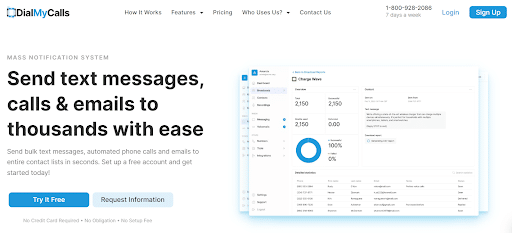
Collecting phone numbers for SMS campaigns doesn’t have to be complicated—when done right.
From online methods like landing pages and pop-ups to offline strategies like point-of-sale sign-ups and printed materials, there are plenty of ways to build a high-quality SMS list. Just remember, the key to success lies in offering real value to your audience, ensuring transparency, and staying compliant with regulations.
Ready to start building your SMS list? DialMyCalls can be just the tool you need. With our simplified processes and automated features, you can execute your SMS marketing strategy just the way it’s supposed to be. So, connect with us today!
Reach Thousands, Instantly
Grow Your Business by Leveraging Mass Texting
